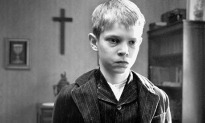by Valerie Siebert
Michael Haneke is one of film’s most unapologetically controversial directors on the scene at the moment, known for infusing his work with a polemic intensity that’s guaranteed to make his viewers squirm in uncertain semi-agreement. His Palme d’Or award winning new film The White Ribbon carries all these same qualities but, unlike his previous efforts (including Cache and The Piano Teacher), adapts the more formulaic genre of the whodunit for his purposes.
The plot, narrated by a local school teacher, revolves around a series of macabre and ominous events that occur in a small German town over a period of the year before the outbreak of the First World War. A rigged wire downs the mounted town doctor, the baron’s son is kidnapped and beaten, and a mentally handicapped boy is nearly blinded-all by an unknown assailant. A farmer’s son sets himself against the owner of the means of production in belief that he is responsible for the death of the boy’s mother, ultimately leading his family into shame, unemployment and tragedy.
Evil and calamity appear to permeate the lives of the entire town which seems to cower beneath the dark shadow of patriarchy and staunch Protestantism, suggesting the sinister events to be the result of a lengthy repression coming to a head. There’s a Children of the Corn-esque creepy solemnity about the children of the town that is further exemplified by the fact that their ages suggest that they would be adults when the Nazi Party takes power.
At well over 2 hours, the film is burdened by its length, but the sheer number of intertwined storylines Haneke uses to support his social commentary works against an argument of shortening it. The cinematography is notable in its stark juxtaposition of extra-real imagery upon overly simple scenery and shot in a sterile, cold and unforgiving black and white.



 Follow Us On Instagram
Follow Us On Instagram
